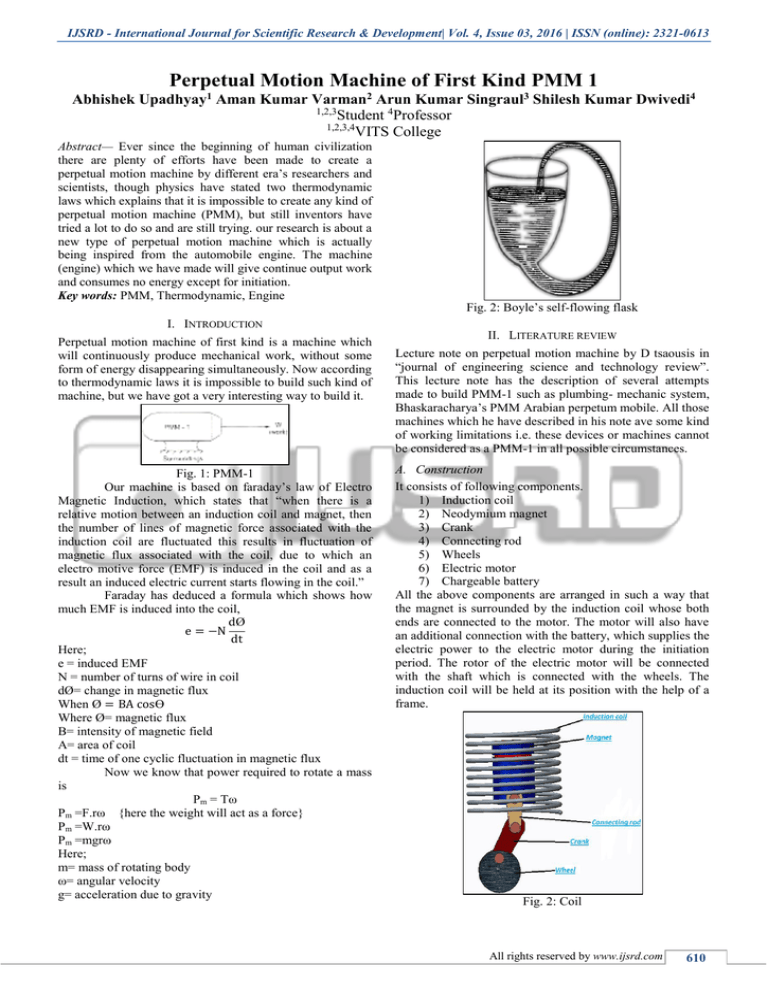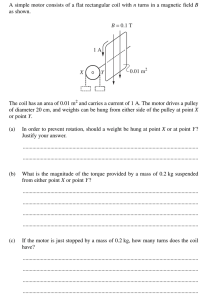
IJSRD - International Journal for Scientific Research & Development| Vol. 4, Issue 03, 2016 | ISSN (online): 2321-0613
Perpetual Motion Machine of First Kind PMM 1
Abhishek Upadhyay1 Aman Kumar Varman2 Arun Kumar Singraul3 Shilesh Kumar Dwivedi4
1,2,3
Student 4Professor
1,2,3,4
VITS College
Abstract— Ever since the beginning of human civilization
there are plenty of efforts have been made to create a
perpetual motion machine by different era’s researchers and
scientists, though physics have stated two thermodynamic
laws which explains that it is impossible to create any kind of
perpetual motion machine (PMM), but still inventors have
tried a lot to do so and are still trying. our research is about a
new type of perpetual motion machine which is actually
being inspired from the automobile engine. The machine
(engine) which we have made will give continue output work
and consumes no energy except for initiation.
Key words: PMM, Thermodynamic, Engine
Fig. 2: Boyle’s self-flowing flask
I. INTRODUCTION
Perpetual motion machine of first kind is a machine which
will continuously produce mechanical work, without some
form of energy disappearing simultaneously. Now according
to thermodynamic laws it is impossible to build such kind of
machine, but we have got a very interesting way to build it.
Fig. 1: PMM-1
Our machine is based on faraday’s law of Electro
Magnetic Induction, which states that “when there is a
relative motion between an induction coil and magnet, then
the number of lines of magnetic force associated with the
induction coil are fluctuated this results in fluctuation of
magnetic flux associated with the coil, due to which an
electro motive force (EMF) is induced in the coil and as a
result an induced electric current starts flowing in the coil.”
Faraday has deduced a formula which shows how
much EMF is induced into the coil,
dØ
e = −N
dt
Here;
e = induced EMF
N = number of turns of wire in coil
dØ= change in magnetic flux
When Ø = BA cosƟ
Where Ø= magnetic flux
B= intensity of magnetic field
A= area of coil
dt = time of one cyclic fluctuation in magnetic flux
Now we know that power required to rotate a mass
is
Pm = Tω
Pm =F.rω {here the weight will act as a force}
Pm =W.rω
Pm =mgrω
Here;
m= mass of rotating body
ω= angular velocity
g= acceleration due to gravity
II. LITERATURE REVIEW
Lecture note on perpetual motion machine by D tsaousis in
“journal of engineering science and technology review”.
This lecture note has the description of several attempts
made to build PMM-1 such as plumbing- mechanic system,
Bhaskaracharya’s PMM Arabian perpetum mobile. All those
machines which he have described in his note ave some kind
of working limitations i.e. these devices or machines cannot
be considered as a PMM-1 in all possible circumstances.
A. Construction
It consists of following components.
1) Induction coil
2) Neodymium magnet
3) Crank
4) Connecting rod
5) Wheels
6) Electric motor
7) Chargeable battery
All the above components are arranged in such a way that
the magnet is surrounded by the induction coil whose both
ends are connected to the motor. The motor will also have
an additional connection with the battery, which supplies the
electric power to the electric motor during the initiation
period. The rotor of the electric motor will be connected
with the shaft which is connected with the wheels. The
induction coil will be held at its position with the help of a
frame.
Fig. 2: Coil
All rights reserved by www.ijsrd.com
610
Perpetual Motion Machine of First Kind PMM 1
(IJSRD/Vol. 4/Issue 03/2016/165)
The current generation capacity of the magnet and
induction coil arrangement is very much dependent on the
resistivity of the material of the induction coil. Since we are
using copper wire then in that case the value of resistivity is
1.7 x 10-8 ohm.mtr. Whereas the magnetic power of the
magnet is concerned then it will be between 10000 gauss to
13000 gauss depending on the grade of the magnet whether
it’s be a N30 grade or N50 grade.
III. WORKING
The working of this machine is based on two phases of
operations. In the first phase the power is supplied to the
electric motor connected in the electric circuit. So the motor
will start rotating, as a result the shaft coupled to it will also
start rotating since the shaft is connected with the wheels so
wheels will start rotating. due to rotation of the wheels the
will oscillate and as a result connecting rod attached to it
will reciprocate up and down. So the magnet connected at
the upper end of the connecting rod will also make an up
and down. So a relative motion between the magnet and
induction coil will occur.
Now the second phase of working starts. Since we
are supplying electricity to the motor, with the help of the
battery so the wheels will rotate for some initial period and
due to rotation of wheels the magnet will reciprocate up and
down, which results in generation of current in the induction
coil which can be now easily supplied to the motor. So now
we can disconnect the battery from the circuit. Now the
motor will run only by electricity which is generating by the
magnet.
Now as the motor runs by electricity, generated by
the magnet, the wheel will also rotate , as the wheels start
rotating it will reciprocate the magnet in and out of the
induction coil. This reciprocation will further generate
electric current which will be again supplied to the motor
which will again rotate the wheels which results in
reciprocation of the magnet in and out of the induction coil
which will further generate electric current and the cyclic
process repeated again and again.
As a conclusion we are rotating the wheels without
any power input once after initiation. At this stage the
machine is producing work output without any energy input
and we know that “a machine producing work output
without any power input is known as perpetual motion
machine of first kind.” It means the machine which we have
created is a PMM-1.
IV. RESULT AND DISCUSS
If we use the neodymium magnet of grade N-30 to N-50
then we can generate significant power output, with an
induction coil of 1000 or more turns of wire. This power
generated will be sufficient to rotate a body with significant
weight. So this machine can be broadly used in the
automobile engines to produce power at no input.
REFERENCES
[1] https://en.m.wikipedia.org/wiki/perpetual_motion
[2] http://www.mechanical-engineeringassignment.com/perpetual-motion-machine-of-the-firstkind-pmm-1
[3] Thermal engineering (SI Units) by R.K. Rajpoot
[4] NCERT Class XII Physics Book Chapter-6
[5] Ioannou A., ntanos I., pittas A., Raptis S, Physics, Form
B of the senior high school, Athens(2000).
Fig. 2: Machine
All rights reserved by www.ijsrd.com
611



